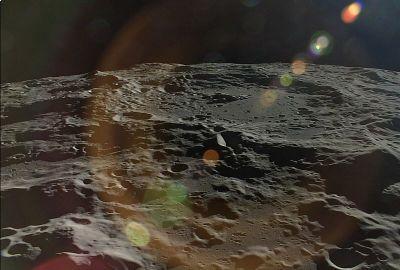The Japanese spacecraft Kagoya, orbiting the moon searched and searched and did not find significant amounts of water that could satisfy the needs of a colony on the moon * The pendulum is now moving in the negative direction

The popular assumption was that there are significant amounts of water ice on the moon, hidden from the scorching sun in shadowy craters. One of these craters is Shackleton Crater, which houses the lunar south pole, and previous missions that orbited the moon indicated that it may contain a large reservoir of ice that would supply the needs of a future lunar colony.
However, the Japanese spacecraft Kagoya (and in English SELENE - an acronym for Selenological and Engineering Explorer) took measurements and photographed the interior of the crater and found nothing. At least it failed to detect significant amounts of ice on the surface, what does this mean for planned lunar colonies?
It all started in 1994, when the American spacecraft Clementine (which was shared by NASA and the Ballistic Missile Defense Organization) carried a bistatic radar experiment ("Bistatic Radar Experiment"), which combined the return of radio signals coming out of the transmitter from the polar regions of the moon. The returned signal was received by NASA's Deep Space Network antennas. The scientists who analyzed with him determined that volatile ice is present on the lunar surface, almost certainly in the form of water ice. However, this claim was challenged after a similar experiment was performed using the radio telescope in Arecibo, Puerto Rico. This time, the area from which the radio waves were returned was bathed in sunlight, where ice cannot survive for even a short time, and results similar to those of Clementine were found.
In 1998, NASA's Lunar Prospector spacecraft transmitted mixed results using a Neutron Spectrometer (NS) instrument. The spacecraft discovered 3 billion tons of water ice near the surface of the moon in the polar regions. However, the mission ended in 1999, and the Lunar Prospector spacecraft crashed into the crater at the south pole of the moon in hopes of blowing a plume of material from the surface and discovering the ice in observations from Earth. Unfortunately, no water was detected in this experiment. The LCROSS spacecraft that will reach the moon in April 2009 (together with the lunar probe LRO), will be sent specifically for this purpose - and will crash on the surface of the moon on purpose, so that the observations will be made both from the Earth and from the spacecrafts orbiting the moon, primarily LRO.
The Japanese spacecraft Kagoya took advantage of an opportunity that came its way to take a closer look at Shackleton Crater, the most likely candidate to hold a supply of water shaded from the sun. Because the moon has no atmosphere, except for a negligible amount of life-extending chemicals, sunlight cannot diffuse into the crater floor and illuminate the surface. However, the scientists took the picture in the middle of the southern lunar summer, when enough light reaches the upper part of the crater walls and illuminates the darkness below with a pale light.
Although it is very cold inside the crater (minus 180 degrees Celsius), excellent conditions for keeping the ice there is no visual evidence of the existence of ice on the surface. The Japanese team concluded that there is nevertheless ice mixed in small amounts in the lunar dust, or that there really is no ice there at all. This will probably be discovered by members of a manned expedition in a few decades.

10 תגובות
They simply said they found no visual evidence of water and thus were completely accurate.
Otherwise there would have been no need for the experiment that eventually discovered water.
It made me laugh that only a year ago this article was written, in which we are once again told that there is no future to find something like life on the moon. And here, the year 2009 and water was discovered.
Ahh, what a life!
Must find!!!!!!!!!!
The necessary condition for there to be water on the moon is that you teach the aliens on it to swim.
Except that the moon is actually made of yellow cheese, so it is likely that there are a lot of mice there and if the aliens allow water to pass in the "world carrier" then the mice will drown.
Best regards, Professor Shavit.
It is possible to plan a mission to smash a comet made mostly of water ice on the moon. This will achieve several goals:
1. We will gain the knowledge regarding planning a system to divert a comet from its orbit - essential to prevent comet/asteroid crashes on Earth
2. From observing the comet crash on the moon through telescopes, there is certainly a lot to learn about the creation of craters, etc.
3. And of course, the comet that smashes into the moon will be able to provide water for a future colony on the moon.
what should we do?
The Sea of Galilee is drying up and even the moon has no water.
Apparently there is no choice, as the well-remembered Marie Antoinette said:-
"If there is no water, we will drink Coke"
Good night
Sabdarmish Yehuda
Eric:
Do not give up!
Dig!
By the way - you probably won't find oil because as far as we know oil is created from plants and animals.
Maybe they will dig? Maybe the water is inside? Maybe it even came out to Hep Neft?
Do not give up!
A manned expedition in a few decades?
disappointing…